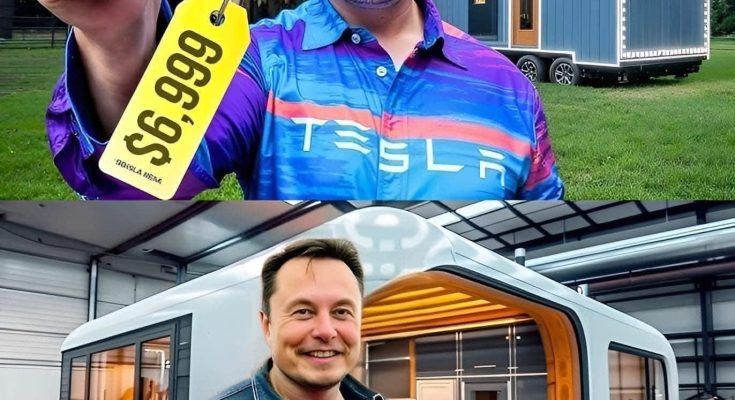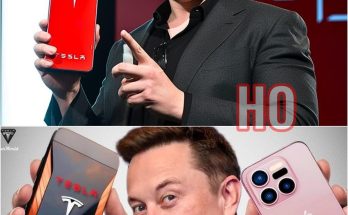IT HAPPENED! Elon Musk’s $10,000 House FINALLY Hitting The Market | HO
Imagine owning a home that’s not only affordable but also sustainable, futuristic, and completely off the grid. A house that costs less than some high-end smartphones and redefines the very concept of modern living. What if we told you that this house isn’t just a far-fetched dream, but it’s about to hit the market, and it’s all thanks to Elon Musk?
That’s right—the $10,000 house, developed by none other than Elon Musk’s company Boxabl, is set to revolutionize the housing industry as we know it. We’ll dive deep into how Musk’s ambitious project is finally coming to life, the technology behind these innovative homes, their potential impact on the housing market, and why this could be a game-changer for millions of people worldwide. Elon Musk has once again sparked global excitement by bringing forth an ambitious solution to a long-standing issue: affordable housing. The much-anticipated “$10,000 House” — a compact, energy-efficient, and innovative modular home developed by the startup Boxabl with Musk’s influence — is set to revolutionize affordable living. Let’s delve into how this revolutionary housing model could transform the real estate industry, making sustainable living more accessible for millions.
Elon Musk has once again sparked global excitement by bringing forth an ambitious solution to a long-standing issue: affordable housing. The much-anticipated “$10,000 House” — a compact, energy-efficient, and innovative modular home developed by the startup Boxabl with Musk’s influence — is set to revolutionize affordable living. Let’s delve into how this revolutionary housing model could transform the real estate industry, making sustainable living more accessible for millions.
Elon Musk has often focused on solutions to global challenges, from renewable energy to sustainable transportation and even space exploration. With the $10,000 House, he has turned his attention to housing affordability. Skyrocketing housing prices have put home ownership out of reach for many, while homelessness and overcrowding continue to rise in urban areas. Musk’s vision is to disrupt the housing market by introducing a sustainable, low-cost, high-quality housing solution that can be quickly deployed and scaled up globally. This aligns with his goal to make life on Earth and potentially Mars more affordable and sustainable.
Technology and Design Behind the $10,000 House
The $10,000 House, also known as the Boxabl Casita, is designed with advanced technology to meet the needs of modern living in a small, energy-efficient space. Here are the key innovations that make it unique:
The Boxabl Casita uses a modular design, allowing each unit to be prefabricated in a factory and transported to the site for assembly. The foldable structure enables it to be delivered in a compact form and then “unfolded” into a complete living space within hours. This minimizes shipping costs and allows the home to be easily delivered to remote or urban locations.
Sustainability is a core component of the $10,000 House. Built with high-quality insulation, energy-efficient windows, and a design that maximizes natural light, it significantly reduces energy consumption. The home is compatible with solar panels and Tesla’s Powerwall, enabling homeowners to generate and store their own energy, potentially living completely off the grid.
True to Musk’s tech-savvy reputation, the $10,000 House comes equipped with smart home features. With Tesla’s Powerwall for energy storage, intelligent thermostats, lighting systems, and security features, residents can control their energy usage efficiently and enhance their living experience.
Despite its low cost, the $10,000 House is engineered to be durable and safe, using materials that can withstand severe weather, including heavy rain, snow, and hurricanes. This attention to quality ensures that it can meet or exceed building codes, providing peace of mind to homeowners.
Bringing the $10,000 House to market has been no small feat. While modular housing has been explored for years, Musk’s involvement brought significant resources and attention to Boxabl, accelerating the development process. Musk himself even lives in a prototype Casita near SpaceX’s facilities in Texas, showcasing his commitment to the project and boosting its credibility. Overcoming funding, production, and regulatory hurdles, the $10,000 House is now set to meet the massive demand from those looking for affordable, sustainable housing.

Potential Impact on the Housing Market
The introduction of the $10,000 House could have several significant impacts on the housing industry:
With a price tag of just $10,000, this house could make home ownership accessible to a broader range of people. This has the potential to address housing insecurity by providing a path to ownership that is affordable and doesn’t require a mortgage.
The housing crisis has disproportionately affected low-income individuals who struggle to find safe, affordable homes. The $10,000 House could play a vital role in tackling this issue, offering a cost-effective solution that can be quickly deployed in both urban and rural settings.
The $10,000 House challenges the conventional real estate model by offering a prefabricated, modular solution that can be assembled on-site in a matter of hours. By introducing competition and driving down housing costs, this innovation could encourage the industry to adopt more efficient and sustainable building practices.
Traditional construction is resource-intensive and has a large carbon footprint. The $10,000 House uses eco-friendly materials, reduces waste, and promotes energy efficiency, offering a green alternative that helps mitigate the environmental impact of housing.
This affordable housing model holds enormous potential for addressing housing shortages worldwide. It could make a profound difference in developing countries, where affordable, quality housing is scarce. Governments and non-profits might use these homes for low-income families, helping to alleviate the global housing crisis. Additionally, the Casita’s compact, foldable design makes it an excellent option for disaster relief and emergency housing, where quick, reliable shelter is essential.
The $10,000 House could influence urban planning strategies in cities struggling with high populations and limited housing. Its modular and scalable design allows it to adapt to various urban needs, such as affordable housing in densely populated areas. Moreover, the ability to stack and combine units could enable planners to build multi-unit complexes that are sustainable, affordable, and energy-efficient.
Challenges and Criticisms
Despite its benefits, the $10,000 House faces certain challenges:
Different locations have unique zoning laws and building codes, which may delay or complicate the deployment of modular homes. Navigating these regulations will require cooperation between Boxabl, local governments, and Musk’s team.
Modular homes often carry a stigma of being temporary or lower quality. Changing public perception and proving the durability and livability of these homes will be essential for widespread adoption.
With significant interest and demand, Boxabl will need to expand production capabilities to meet consumer expectations without compromising quality.
As the $10,000 House gains traction, it’s likely that competitors will introduce their own affordable modular homes. Boxabl and Musk will need to innovate continuously to maintain a competitive edge.
Boxabl is expected to implement a pre-order system to help interested buyers reserve their homes. Potential buyers are advised to stay updated on Boxabl’s official site, prepare for local zoning and building regulations, and arrange for basic site preparation. Once delivered, the home can be assembled within hours, allowing homeowners to customize the space with additional modules, solar panels, and more.
The $10,000 House is not just a housing solution; it’s a potential catalyst for change across various sectors. By addressing the global housing crisis, promoting affordable urban planning, and inspiring further innovation, this project demonstrates the transformative power of accessible technology. Additionally, it opens the door to further advancements, such as larger modular homes, expanded smart home capabilities, and new urban planning approaches.
The $10,000 House is a testament to Musk’s belief in harnessing technology for large-scale impact. Through Boxabl’s modular design, energy-efficient technology, and foldable structure, this home stands to redefine what’s possible in affordable housing. If successful, it could serve as a model for other affordable, sustainable housing projects, demonstrating a future where high-quality living is not just a luxury but a standard for everyone.



